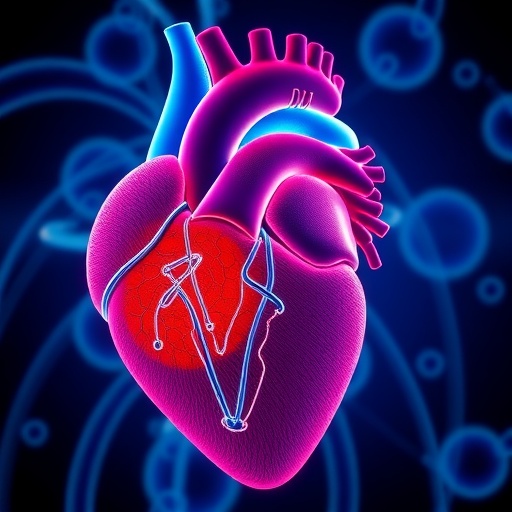
In a groundbreaking study published in the Journal of Artificial Organs, researchers have shed light on the hemodynamic changes and mid-term outcomes following surgical interventions for de novo aortic valve insufficiency in patients who have undergone left ventricular assist device (LVAD) implantation. This research holds significant implications for the management of patients with advanced heart failure, particularly as the understanding of cardiac mechanics continues to evolve in the era of advanced mechanical circulatory support.
The study, led by Murakami et al., marks a pivotal step in cardiovascular research, focusing on the aortic valve’s performance post-LVAD implantation. Patients with LVADs often experience complications related to valve function, particularly aortic valve insufficiency, which can further compromise cardiac output. Previous studies have suggested that such insufficiencies may arise as a result of altered hemodynamics due to LVAD support, but a comprehensive analysis of these changes post-surgery had yet to be undertaken.
At the core of the research lies the investigation into how surgical correction of aortic valve insufficiency can improve hemodynamic parameters. The analysis presented by the authors provides insight into how these corrective procedures not only stabilize heart function but also enhance patients’ quality of life. Additionally, this work raises important questions regarding the timing of intervention and the criteria for selecting appropriate candidates for surgery. The researchers emphasize that deeper insights into hemodynamic alterations could enhance the decision-making process in clinical settings.
Moreover, the study involved a significant cohort of patients who were closely monitored for several months following the surgical correction of aortic valve insufficiency. The authors meticulously tracked various parameters, including cardiac output, systemic vascular resistance, and pulmonary artery pressures. By doing so, they were able to create a detailed picture of how surgical interventions impact hemodynamics over the medium term.
The findings revealed that patients who underwent surgery demonstrated considerable improvements in their hemodynamic status compared to those who did not receive surgical intervention. These results suggest that addressing aortic valve insufficiency is not merely a selective surgical challenge but a necessary component of comprehensive heart failure management in patients with LVADs. Furthermore, the implications of these findings extend beyond just immediate postoperative outcomes; they hint at long-term survival benefits and enhanced functional capacity in these patients.
In exploring hemodynamic changes, the research team highlighted key indicators that reflect cardiac efficiency. For instance, the normalization of left ventricular dimensions and the improvement in ejection fraction post-surgery were significant markers that correlated with patient outcomes. These changes are crucial as they reflect the heart’s ability to pump effectively under altered conditions introduced by LVAD support.
Interestingly, the authors also drew attention to the relationship between preoperative characteristics and postoperative outcomes. An analysis of variables such as age, comorbidities, and duration of LVAD support prior to surgery provided valuable insights into the patient profiles best suited for surgical correction. This information could lead to more personalized treatment plans and better overall patient management.
The mid-term results presented in the study underscore the overarching need for continuous evaluation of patients following LVAD implantation. Clinicians must remain vigilant in monitoring for aortic valve insufficiency, as its development can have cascading effects on patient outcomes. The study advocates for regular echocardiographic examinations and clinical assessments to preemptively identify and address valve-related complications.
As the field evolves, the integration of multi-disciplinary approaches remains essential. Surgeons, cardiologists, and heart failure specialists must work collaboratively to ensure that patients receive the most appropriate interventions tailored to their unique circumstances. This mutual understanding could lead to refined protocols for managing hemodynamic changes and surgical options available to patients with LVADs.
While the study by Murakami et al. provides a compelling overview of mid-term results following surgical corrections, it also serves as a springboard for future research. There are still numerous aspects of aortic valve insufficiency that warrant closer examination, including the long-term durability of valvular repairs and the impact on functional status over years, rather than months. Researchers may also consider the influence of novel therapies that could mitigate hemodynamic changes further, thereby enhancing patient outcomes.
Additionally, advancing technologies in cardiovascular imaging and hemodynamic monitoring offer exciting opportunities to deepen our understanding of changes post-LVAD. Real-time assessments could potentially enable clinicians to make informed decisions regarding both surgical and non-surgical interventions with greater precision.
In summary, this critical research provides vital evidence that supports surgical correction of de novo aortic valve insufficiency in LVAD patients. The hemodynamic benefits noted following these interventions show promise for improving patient quality of life and long-term outcomes. As the landscape of heart failure management continues to evolve, studies like these will guide future practices and inspire new avenues of exploration within cardiovascular medicine.
Emerging data from the research underscores crucial relationships that must be recognized in clinical practice. The studies that capture these intricate dynamics help to illuminate pathways to improved patient care strategies, thereby influencing not just individual patient management but also broader healthcare policies related to advanced heart failure treatment. The fusion of technological advancement with clinical insight marks the future of cardiovascular medicine, paving the way for a more effective approach to treating those with severe heart conditions.
As health professionals grapple with the complexities of heart failure management, the insights shared by Murakami et al. in this research provide a promising framework for addressing aortic valve insufficiency in patients with LVADs. This study not only documents the immediate effects of surgical intervention but also lays the foundation for ongoing investigation into long-term outcomes, ultimately shaping the future trajectory of cardiac care.
Subject of Research: Hemodynamic changes and mid-term results of surgical correction of aortic valve insufficiency post-LVAD implantation
Article Title: Hemodynamic changes and mid-term results of surgical correction of de novo aortic valve insufficiency after left ventricular assist device implantation.
Article References:
Murakami, T., Misumi, Y., Yoshioka, D. et al. Hemodynamic changes and mid-term results of surgical correction of de novo aortic valve insufficiency after left ventricular assist device implantation.
J Artif Organs (2025). https://doi.org/10.1007/s10047-025-01516-9
Image Credits: AI Generated
DOI: 10.1007/s10047-025-01516-9
Keywords: Aortic valve insufficiency, LVAD, hemodynamics, surgical correction, heart failure management.
Tags: advanced heart failure management strategiesaortic valve repair outcomescardiac mechanics evolutioncardiovascular research advancementshemodynamic changes post-LVADLVAD and aortic valve insufficiencymechanical circulatory support implicationsmid-term results after VADpatient quality of life improvementssurgical correction of valve insufficiencysurgical interventions for heart failurevalve function complications in LVAD patients





